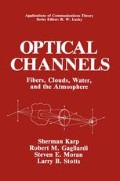Abstract
In this chapter we will introduce the concept of field coherence, which is necessary to describe fully the propagation of electromagnetic fields in both free space and nonvacuous channels. In particular, the ideas of temporal and spatial coherence will be presented together with the concept of the mutual coherence function. We will derive the equations which govern the propagation of both the field and the mutual coherence function in free space. In doing so, we will quantify the notions of monochromaticity and narrowbandedness. Finally, we will show how the presence of both nonvacuous channels and receiver optics affects the quantities defined above. Since the concepts discussed in this chapter do not relate strongly to problems in fiber transmission, those readers primarily interested in fibers can skip this chapter and proceed to Chapter 3. The concepts in this chapter lay the groundwork for subsequent introduction of generalized radiometry, which describes power flow for partially coherent fields. However, because of the specialized nature of this topic, it will be pursued in Appendix A.
Access this chapter
Tax calculation will be finalised at checkout
Purchases are for personal use only
Preview
Unable to display preview. Download preview PDF.
References
J. W. Goodman, Introduction to Fourier Optics, McGraw-Hill, New York (1968).
M. Born and E. Wolf, Principles of Optics, Second Edition, Pergamon Press, New York (1964).
J. Dugundji, “Envelopes and pre-envelopes” of real waveforms, IEE Trans. Inf. Theory IT-4, 53 (1958).
R. M. Gagliardi and S. Karp, Optical Communications, Wiley-Interscience, New York (1976).
P. A. Bello, Characterization of randomly tune-variant linear channels, Section V, IEEE Trans. Commun. Systems CS-11, 360 (1963).
Author information
Authors and Affiliations
Rights and permissions
Copyright information
© 1988 Springer Science+Business Media New York
About this chapter
Cite this chapter
Karp, S., Gagliardi, R.M., Moran, S.E., Stotts, L.B. (1988). Coherence Theory and Random Channels. In: Optical Channels. Applications of Communications Theory. Springer, Boston, MA. https://doi.org/10.1007/978-1-4899-0806-3_2
Download citation
DOI: https://doi.org/10.1007/978-1-4899-0806-3_2
Publisher Name: Springer, Boston, MA
Print ISBN: 978-1-4899-0808-7
Online ISBN: 978-1-4899-0806-3
eBook Packages: Springer Book Archive

